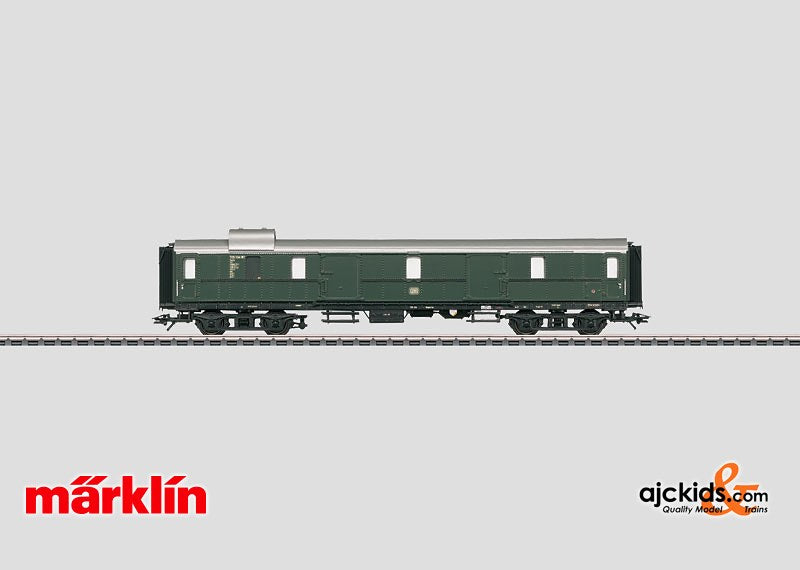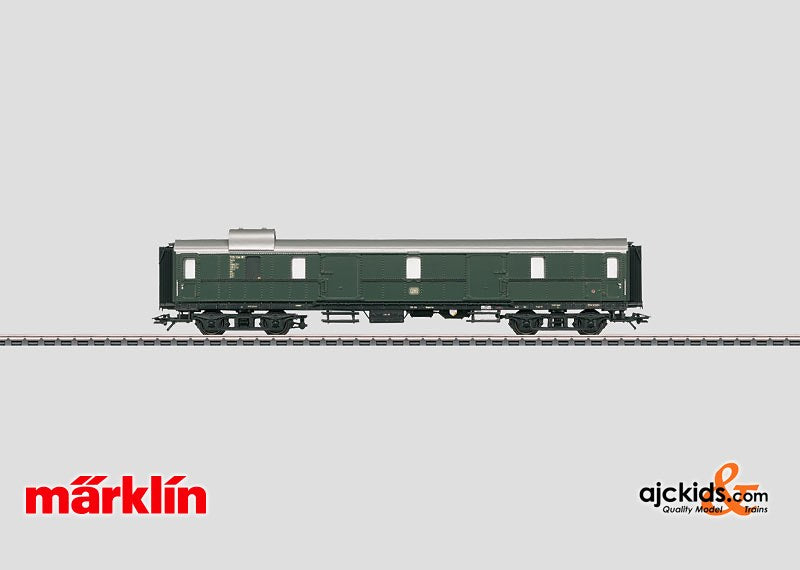Marklin 42260 - Express Train Passenger Car
Prototype: German Federal Railroad (DB) "Hechtwagen" / "Pike Cars" baggage car. Type Pw4ü. The car looks as it did around 1959.
Highlights
- The "Hechtwagen" / "Pike Car" family is completely new tooling.
Product description
Model: The car is constructed with many details and comes in the full length for the scale. The underbody and the trucks are specific to this car. The car is made to look as it did in Era III with a "bottle green" paint scheme. The 7319 current-conducting coupling or the 72020/72021 current-conducting coupler, the 73400/73401 (2 per car) lighting kit, and the 73404 pickup shoe can be installed in the cars.
Minimum radius for operation 360 mm / 14-3/16".
Length over the buffers 21.7 cm / 8-1/2". DC wheel set 4 x 700580.
Charlie's Tip
The class 23 and 39 are appropriate motive power for these cars and can be found in the Märklin H0 assortment under item nos. 39230 and 39390.
A similar model in a DC version can be found in the Trix H0 assortment with Era IIIa lettering under item no. 23387.
Publications
- New items brochure 2009 - Product programme 2009/2010 - Product programme 2010/2011 - Product programme 2011/2012Prototype information
"Hechtwagen" / "Pike Cars" The First Standard Design Cars on the German State Railroad. At the start of the Twenties, when the decision was made to merge the individual state railroads into the German State Railroad Company (DRG), the managers were confronted with an almost unmanageable variety of rolling stock, which caused problems and higher costs in daily operation of a tightly managed firm. The decision was made to standardize both in the awarding of contracts for new locomotives and the purchase of new cars that were urgently necessary in the aftermath of the extreme demands placed on them in the war years. Emphasis was placed on massively lowering costs. Quick results were achieved in the area of passenger cars and as early as 1922 and 1923 the first all-German, newly developed family of cars was ready to be presented to the public: the family of "Hechtwagen" / "Pike Cars" constructed of iron. The name for these very reliable cars came from the wedge-shaped tapering car ends that were already in use on the Saxon State Railroad. However, it turned out that this unusual form was not an improvement either visually or technically and they were discarded in the building plans as early as 1928. In addition to being constructed of iron, another common feature of these cars was the use of wood for interior walls and for lining the ceilings. The cars were laid out with compartments with a side corridor, a sturdy barrel-shaped roof instead of the Prussian clerestory type of roof, ladders on the ends of the cars, and side windows with rather rounded corners. The cars were equipped with electric lighting and "Knorr Kunze S" type air brakes. In 1922, the car program included type A4ü-23 car, 1st class, type B4ü-22 cars, 2nd class, (both types were initially planned only for the "Hapag-Lloyd trains"), type AB4ü-23a/b/c cars, 1st/2nd class, type C4ü-23 cars, 3rd class, and type Pw4ü-23 baggage cars. The latter did not have the standard length of 20,610 mm / 67 feet 7-7/16 inches; they were only 18,840 mm / 61 feet 9-3/4 inches. The baggage cars also differed in having Prussian standard design trucks. The other cars were equipped with trucks of an American design. The "Hechtwagen" or "Pike Cars" could be seen in daily service in express trains all over Germany. Their robust construction was so reliable that in addition to the German Federal Railroad taking over these cars after World War II, other railroads such as the German State Railroad (DR) or the Austrian Federal Railways (ÖBB) also incorporated into their rolling stock the cars still in their areas. The German Federal Railroad retired the originally "German" "Hechtwagen" or "Pike Cars" by the mid-Sixties. Similar designs of Polish origin were still in use for a few more years. Several "Hecht" cars were converted to maintenance cars and were even painted in ocean blue.
Features
Warning
EAN/UPC: 4001883422602



